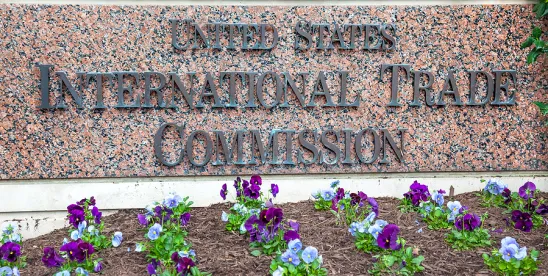Not in our view. In taking the position that ITC proceedings are not covered because they do not seek damages, insurers miss the point.
Not in our view. In taking the position that ITC proceedings are not covered because they do not seek damages, insurers miss the point.
Defense costs incurred by policyholders while both a lawsuit and ITC proceedings are pending should be covered under the CGL policies as recoverable defense costs given the the ITC proceeding’s preclusive effect on the associated trade dress litigation.
When a federal court trade dress infringement suit is brought concurrently with an ITC proceeding that features identical issues of trade dress validity, scope and infringement, the defense of those issues are effectively litigated only once. See 28 U.S.C. § 1659(a). 28 U.S.C. § 1659 (“Section 1659”) states in pertinent part:
(a) STAY.—In a civil action involving parties that are also parties to a proceeding before the United States International Trade Commission under section 337 of the Tariff Act of 1930, at the request of a party to the civil action that is also a respondent in the proceeding before the Commission, the District Court shall stay, until the determination of the Commission becomes final, proceedings in the civil action with respect to any claim that involves the same issues involved in the proceeding before the Commission….
(b) USE OF COMMISSION RECORD.—Notwithstanding section 337(n)(1) of the Tariff Act of 1930, after dissolution of a stay under subsection (a), the record of the proceeding before the United States International Trade Commission shall be transmitted to the district court and shall be admissible in the civil action…Section 1659 thus allows the accused infringer to defend both the federal action and the ITC proceeding by adjudicating the issue one time and having that determination be binding in both matters. See In re Princo Corp., 478 F.3d 1345, 1355 (Fed. Cir. 2007) (“The purpose of §1659 is to prevent separate proceedings on the same issues occurring at the same time. The legislative history states that § 1659 was [enacted]… ‘to address the possibility that infringement proceedings may be brought against imported goods in two forums at the same time.’ H.R. Rep. No. 103-826(I), at 141 (1994), reprinted in 1994 U.S.C.C.A.N. 3773, 3913.”).
Following a final determination by the ITC, the entire record of the ITC proceeding is transmitted to the district court to use to resolve the underlying claims for damages. See In re Princo Corp., 478 F.3d at 1355 (“The legislative history explains that ‘use of the Commission record could expedite proceedings and provide useful information to the court.’ H.R. Rep. No. 103-826(1), at 142, reprinted in 1994 U.S.C.C.A.N. at 3914. The Commission record will be most helpful to the district court if it is a complete record of the Commission proceedings including all remand proceedings.”).
Furthermore, in non-patent cases like trade dress infringement proceedings, the ITC’s findings and determinations are given preclusive effect—binding the parties in both the federal action and the ITC proceeding. See, e.g., Mahindra & Mahindra Ltd. v. FCA US LLC, 503 F. Supp. 3d 542, 548-55 (E.D. Mich. 2020) (“Mahindra”) (recognizing that ITC proceedings have a preclusive effect on trade dress claims and granting dueling summary judgment motions based solely on the ITC’s findings and determinations). The preclusive effect is not only binding, but also reflects Congressional intent to have certain claims for damages defended only once, even though proceedings are pending in the court and the ITC. See id. at 549-50; see also McCarthy on Trademarks and Unfair Competition § 29.55 (5th Ed. 2023) (“Res judicata from an [ITC] decision may be created so as to bar relitigation of the same claim or issue in a [parallel] federal court case. An [ITC] finding that complainant had no valid trademark was held to be res judicata and precluded the losing complainant from [continuing to pursue] an identical [claim] in district court rather than appealing the ITC decision to the Federal Circuit.”) (citations omitted).
While no reported California case has addressed the issue, existing California case law supports the proposition that recoverable defense costs include costs incurred after the tender of defense, but before the conclusion of the suit, and which relate to “reasonable and necessary effort[s] to avoid or at least minimize liability.” Aerojet–General Corp. v. Transport Indemnity Co., 17 Cal.4th 38, 61 (1997).
In Aerojet, the California Supreme Court evaluated whether the insurers’ duties to defend required them to pay environmental investigation expenses imposed by an administrative order outside of the context of the covered litigation. Id. at 70. The California Supreme Court determined that “the insured’s site investigation expenses constitute defense costs that the insurer must incur in fulfilling its duty to defend” under the following conditions: (1) the site investigation must be conducted within the temporal limits of the insurer's duty to defend, i.e., between tender of the defense and conclusion of the action; (2) the site investigation must amount to a reasonable and necessary effort to avoid or at least minimize liability; and (3) the site investigation expenses must be reasonable and necessary for that purpose. Id. at 60-61.
As in Aerojet, defense costs incurred by policyholders while both trade dress litigation and associated ITC proceedings are pending potentially meet all three of these requirements. Specifically, the binding nature of the ITC’s findings and determinations on the validity and scope of any claimed trade dress means that defending these claims before ITC directly benefits the defense in the concurrent court proceedings—making the costs of the ITC defense necessary to “avoid or minimize liability” in the court proceedings.
Accordingly, policyholders should consider pursuing coverage for ITC proceedings alleging trade dress infringement.




 />i
/>i

